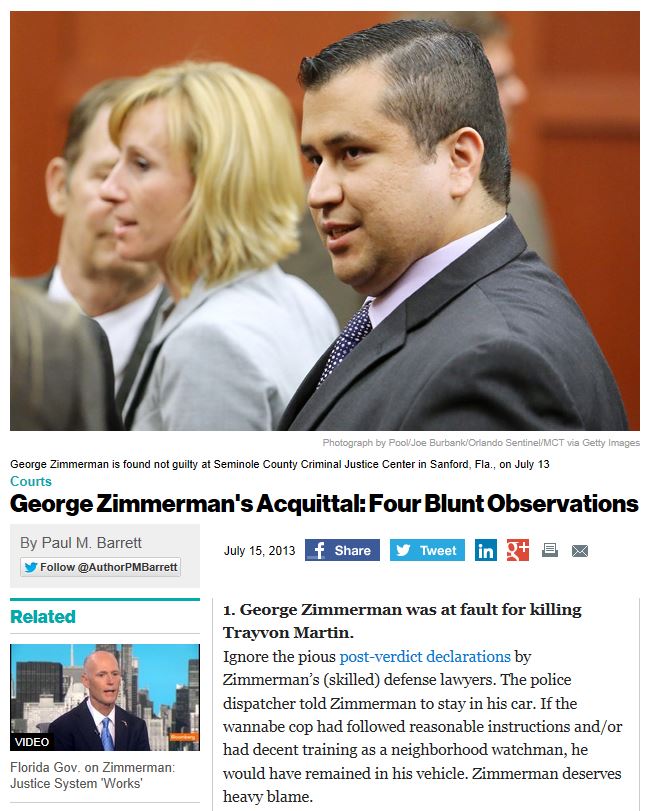There are many lessons to be learned from the media miscoverage of the George Zimmerman shooting of Trayvon Martin.
We’ve dealt repeatedly with the false “hoodie” and racial narratives, the ludicrous audio and video analyses, and the misunderstanding of the role Stand Your Ground played [actually, did not play] in the case.
We’ve seen post-trial articles about how the prosecution failed to “humanize” Trayvon, without addressing that the prosecution deliberately didn’t go there because it would have brought into evidence Trayvon’s history of fighting, drug use and illegal weapons possession. Rachel Jeantel’s post-trial interview on CNN also raised the possibility that the fight was started by Trayvon out of homophobic fear that Zimmerman was a sexual predator.
In this sea of media malpractice, one enduring fabrication lives on despite conclusive trial testimony, the concept that Zimmerman was ordered, instructed, or told not to get out of his car by the 911 operator.
I completely debunked this concept when it was assumed by Jonathan Capehart at WaPo, In busting Zimmerman myths, Jonathan Capehart perpetuates the greatest myth of all. I emailed Capehart about it, he responded “fair point,” and as of this writing the offending comment about Zimmerman being told not to get out of this car no longer is in Capehart’s column. Good for him.
But the myth lives on in part because other media is not as responsible.
One example brought to my attention by a reader was an article by Paul M. Barrett at Bloomberg BusinessWeek, George Zimmerman’s Acquittal: Four Blunt Observations (emphasis mine):
1. George Zimmerman was at fault for killing Trayvon Martin.
Ignore the pious post-verdict declarations by Zimmerman’s (skilled) defense lawyers. The police dispatcher told Zimmerman to stay in his car. If the wannabe cop had followed reasonable instructions and/or had decent training as a neighborhood watchman, he would have remained in his vehicle. Zimmerman deserves heavy blame.
The reader emailed Barrett on July 15, referencing my prior post, with the following subject line “Your Bloomberg Zimmerman Blunt Observation #1 factually wrong…”:
Regarding your recent Bloomberg Businessweek OpEd (available at http://www.businessweek.com/articles/2013-07-15/george-zimmermans-acquittal-four-blunt-observations ):
Per William A. Jacobson, Clinical Professor of Law at Cornell Law School, Zimmerman was out of his car before the police dispatcher
told him the police diidn’t “need” him to follow Martin:
I was copied on the email, and responded to Barrett as well:
Yes, that’s pretty outrageously wrong Mr. Barrett. I trust you will correct your column promptly and clearly.
William Jacobson
Legal Insurrection Blog
I also sent out two tweets calling attention to the error and wondering why it had not been corrected:
#wrong: "The police dispatcher told Zimmerman to stay in his car"http://t.co/6CONSUOTcL via @AuthorPMBarret
— Legal Insurrection (@LegInsurrection) July 15, 2013
Still wrong despite req 4 correction: "dispatcher told #Zimmerman 2 stay in car" http://t.co/6CONSUOTcL –> @AuthorPMBarrett
— Legal Insurrection (@LegInsurrection) July 16, 2013
As of this writing, no correction. There are over 2500 comments to the post, indicating it was fairly widely read. By people many of whom will never know that Blunt Observation #1 was factually wrong.
This is hardly the worst example. But it’s illustrative of the problem with a media which gets it wrong, and refuses to correct the record once the error is called to its attention.
There is a second and implicit part of the myth, namely that Zimmerman was told not to follow Martin (in addition to being told not to get out of his car). Jonathan Capehart, in the column noted above, correctly debunked that myth, Five myths about the killing of Trayvon Martin:
“Are you following him?” the operator for the Sanford police’s non-emergency line asks Zimmerman. “Yeah,” he says. The dispatcher on the phone tells him: “We don’t need you to do that.”
Who the aggressor was that fateful night is the central — and most unanswerable — question of the case. Those who fault Zimmerman have latched on to this back-and-forth with Sean Noffke, the operator, as proof that Zimmerman defied a direct police order.
Not so. Noffke testified on the first day of the jury trial that it is dispatchers’ policy not to give orders to callers. “We’re directly liable if we give a direct order,” he explained. “We always try to give general basic . . . not commands, just suggestions.” So, “We don’t need you to do that” is different than a more direct “Don’t do that.”
Under cross-examination, Noffke added more context to his “suggestion” when asked whether his requests for updates on what Martin was doing encouraged Zimmerman to follow the unarmed 17-year-old. “It’s best to avoid any kind of confrontation, to just get away from the situation,” Noffke said.
If the media refuses to correct the obvious factual inaccuracy that Zimmerman was told not to get out of his car, it seems hopeless to get the media to correct this other part of the myth. Capehart made a good attempt at it, as have others, to no avail..
The myth will survive because it is part of the background narrative, an assumption upon which arguments implicitly rest.
Regardless of what they think of the verdict, most Americans will go to their graves believing the myth that “if only George Zimmerman had not gotten out of the car when the police told him not to.”
 DONATE
DONATE
Donations tax deductible
to the full extent allowed by law.








